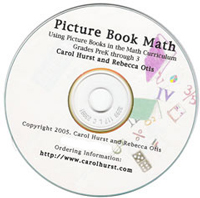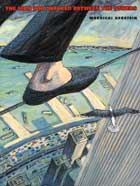Newsletter, Volume 14, Number 3
Welcome to our newsletter. If you'd like to have each issue delivered to your email address you can sign-up for a subscription.
Picture Book Math Excerpt

This issue contains the introduction and an excerpt from Picture Book Math.
Picture Book Math: Using Picture Books in the Math Curriculum, Prekindergarten through Third Grade is a CD eBook that Carol Hurst and I (Rebecca Otis) wrote before her death. This is the second edition.
This particular section covers a specific picture book, The Man Who Walked Between the Towers and explores ways to use it in first through third grade to strengthen math skills. This picture book can be used beyond the third grade range of the eBook CD and brought right through high school. In fact, the estimating a building height activity below is done in eleventh grade geometry in our local high school.
If you would like more information on this eBook you can go to:
http://www.carolhurst.com/products/pbmcd.html
Introduction to Picture Book Math
Most of us, when we consider the teaching of math at any level, think of building number concepts and strategies through manipulatives, going slowly from the concrete to the abstract as the children show understandings of the concepts. This book makes no attempt to change that. Our nefarious plan is to get picture books inserted in that process — around the manipulative activities and before and during the abstract levels for each concept.
We all know the magic that can happen when we gather a circle of students around us and share a favorite picture book. And we know that not just any book will do. First and foremost the story must stand on its own. We can share a good story from start to finish; no "lessons," no pressures, no distractions. In so doing, we share the power of the written word, the delight of good artwork, the humor or unique perspective of an author or illustrator.
However, in addition to a rich supply of these unfettered experiences, we know that sometimes the reading of a picture book is the perfect time to play with language, to notice how it works, to reflect on what we know and what we are learning. In the context of story there are many opportunities that lead to new discoveries about language and art.
Similarly there are opportunities to play with mathematical ideas and to make new discoveries about the mathematical world around us while sharing a picture book. Stories create their own world of possibilities and invite us to enter and explore.
Illustrations are rich with patterns, something the students are discovering as the basis of mathematics. The language of picture books is often patterned and rhythmic, again using this mathematical idea to create something powerful or playful. Picture books can open new areas of interest, inviting us to find out more: a perfect opportunity to collect data and look for the patterns in it that will help us to understand. Furthermore, some picture books set before us problems that mathematical strategies can help us to solve: What do we know? What patterns can we see? How can these patterns help us to predict possible solutions? How can we test these solutions?
Why bother with that? Why make one more step in an already crowded curriculum? Partly because it is overcrowded and pulling one curriculum area into another saves time. No matter what you are teaching in the elementary school, you are teaching reading, and there’s never enough time for the right amount of reading aloud and leisure reading in a day already packed full of the so-called basics. If we can pull a little reading into the math program or a little math into the reading program, we can enrich both areas.
There are, of late, some picture books being published with that very thing in mind, and some of them are quite good. The majority, however, suffer from the same thing that ails stories that are created with a subversive motive: stories that attempt to change behavior or teach lessons usually fail as stories.
The books we’ve selected here are, first and foremost, good stories. They are meant to inform, delight, or entertain. The fact that some math concepts can be strengthened by the various plot devices in those stories gives us a double bonus.
The Man Who Walked Between the Towers by Mordicai Gerstein. Math Activities.

Hope everyone out there is having a wonderful Spring (or fall in the Southern Hemisphere). As always, we'd love to hear any of your thoughts about this newsletter or requests for future newsletters. Use our feedback form.
Happy reading!
Rebecca Otis

Related Areas Within Carol Hurst's Children's Literature Web Site
- Math and Children's Literature
http://www.carolhurst.com/subjects/math/math.html - The Man Who Walked Between the Towers by Mordicai Gerstein. A Featured Book Teachers' Guide for this book including classroom activities, related books and links.
- Picture Book Math eBook on CD by Carol Hurst and Rebecca Otis.
Advertisement:
Advertisement:
Advertisement:

